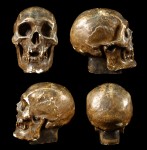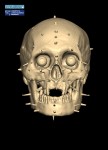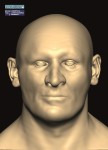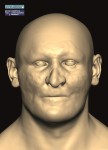 Robert the Bruce, hero of Bannockburn and King of Scots (r. 1306-1329) He died comparatively young, a month before 55th birthday, of an unknown ailment. His body was buried in Dunfermline Abbey where a passel of Scottish kings and queens were laid to rest. The abbey was sacked in 1560 during the Scottish Reformation. The parts of it that survived the sacking fell into ruin. The nave was repaired and used as a parish church until the early 19th century when a new church was built on the site of the Benedictine abbey. Construction workers building the new parish church in 1818 unearthed the bones of Robert the Bruce in a vault underneath what was once the high altar. His remains were sealed in pitch and reburied with great pomp and circumstance, but a cast was made of the skull before the reburial.
Robert the Bruce, hero of Bannockburn and King of Scots (r. 1306-1329) He died comparatively young, a month before 55th birthday, of an unknown ailment. His body was buried in Dunfermline Abbey where a passel of Scottish kings and queens were laid to rest. The abbey was sacked in 1560 during the Scottish Reformation. The parts of it that survived the sacking fell into ruin. The nave was repaired and used as a parish church until the early 19th century when a new church was built on the site of the Benedictine abbey. Construction workers building the new parish church in 1818 unearthed the bones of Robert the Bruce in a vault underneath what was once the high altar. His remains were sealed in pitch and reburied with great pomp and circumstance, but a cast was made of the skull before the reburial.
 There are no reliable contemporary written or artistic depictions of Robert the Bruce’s appearance. He had suffered multiple bouts of serious illness during his lifetime, and some English chroniclers intimated he was afflicted with leprosy. No Scottish reports mention any such affliction. Modern technology could answer many questions about Bruce if his bones were available for research, but they are not. All we have is the cast of the skull of which there are several copies.
There are no reliable contemporary written or artistic depictions of Robert the Bruce’s appearance. He had suffered multiple bouts of serious illness during his lifetime, and some English chroniclers intimated he was afflicted with leprosy. No Scottish reports mention any such affliction. Modern technology could answer many questions about Bruce if his bones were available for research, but they are not. All we have is the cast of the skull of which there are several copies.
 University of Glasgow professor of Scottish history Dr. Martin MacGregor had a brainwave when he saw a documentary featuring the facial reconstruction of Richard III. He realized the technology was advanced enough now that it might work on the cast of Robert the Bruce’s skull in the University’s Hunterian Museum. He reached out to Professor Caroline Wilkinson, Director of Liverpool John Moores University (LJMU)’s Face Lab, an expert in craniofacial identification who created the facial reconstruction of Richard III.
University of Glasgow professor of Scottish history Dr. Martin MacGregor had a brainwave when he saw a documentary featuring the facial reconstruction of Richard III. He realized the technology was advanced enough now that it might work on the cast of Robert the Bruce’s skull in the University’s Hunterian Museum. He reached out to Professor Caroline Wilkinson, Director of Liverpool John Moores University (LJMU)’s Face Lab, an expert in craniofacial identification who created the facial reconstruction of Richard III.
 A careful examination of the cast of Robert the Bruce’s skull does show signs of what could be leprosy. There are osteological changes to his upper jaw and nose consistent with Hansen’s Disease, but the evidence is not conclusive. Dr. Wilkinson therefore took a two-pronged approach to the reconstruction: a younger man in full health, and an older one with scarring from leprosy.
A careful examination of the cast of Robert the Bruce’s skull does show signs of what could be leprosy. There are osteological changes to his upper jaw and nose consistent with Hansen’s Disease, but the evidence is not conclusive. Dr. Wilkinson therefore took a two-pronged approach to the reconstruction: a younger man in full health, and an older one with scarring from leprosy.
Professor Wilkinson said: “Using the skull cast, we could accurately establish the muscle formation from the positions of the skull bones to determine the shape and structure of the face. But what the reconstruction cannot show is the colour of his eyes, his skin tones and the colour of his hair. We produced two versions – one without leprosy and one with a mild representation of leprosy. He may have had leprosy, but if he did it is likely that it did not manifest strongly on his face, as this is not documented.” […]
Professor Wilkinson added: “In the absence of any DNA, we relied on statistical evaluation of the probability of certain hair and eye colours, conducted by Dr MacGregor and his team, to determine that Robert the Bruce most likely had brown hair and light brown eyes.”
“There have also been a number of advances in facial reconstruction techniques since previous depictions of this Scottish hero, including better facial feature prediction and more advanced CGI.”
“This is the most realistic appearance of Robert the Bruce to-date, based on all the skeletal and historical material available.”
This video walks through the facial reconstruction:
This one reconstructs his long-lost tomb, destroyed during the reformation.